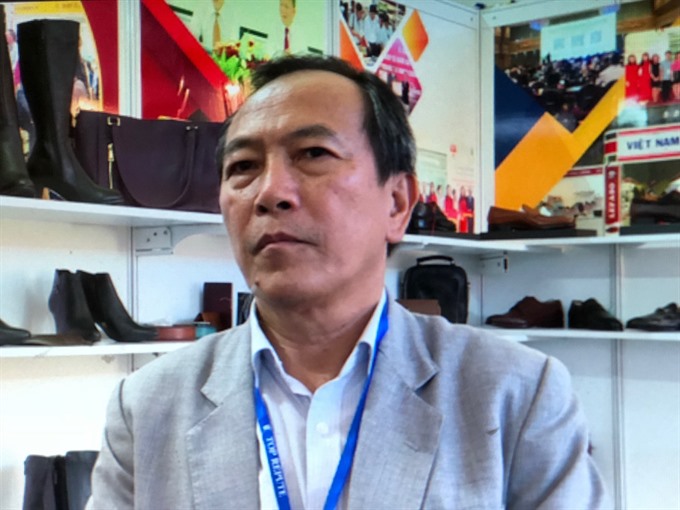 Economy
Economy

Việt Nam’s footwear exports have been worth US$9.45 billion in the first half of this year, a year-on-year increase of 8.4 per cent.
 |
| Diệp Thành Kiệt, Lefaso’s deputy chairman. |
Việt Nam’s footwear exports have been worth US$9.45 billion in the first half of this year, a year-on-year increase of 8.4 per cent.
According to the Việt Nam Leather and Footwear Association (Lefaso), footwear companies have faced challenges due to the US-China trade spat and rapid progress of the fourth industrial revolution.
Diệp Thành Kiệt, Lefaso’s deputy chairman, talks to Việt Nam News about these issues.
What are the advantages and challenges for the footwear industry and what do you think about its export prospects this year?
Việt Nam’s leather and footwear export can reach US$19.5 billion or slightly higher depending on the situation.
We see many advantages for Việt Nam’s leather and footwear sector.
Negotiations for the Comprehensive and Progressive Agreement for Trans-Pacific Partnership have concluded and according to the Vietnamese negotiating team, it is likely that the agreement will come into effect in 2019. With the agreement, we will automatically have free trade agreements with three more countries we do not have FTAs with - Canada, Mexico and Peru - and do not have to negotiate with each country. This is the first advantage.
Secondly, according to the Ministry of Industry and Trade, the Việt Nam - EU Free Trade Agreement can be split into two separate ones - the Free Trade Agreement and the Investment Protection Agreement (CPTPP) - and will be approved in 2019.
Thirdly, we have a golden demographic ratio with more than 60 per cent of the population being of working age, providing an abundant supply of cheap and skilled workers.
In addition, the country has succeeded in shifting to production and export of high-value products.
These are big opportunities for the industry.
But we also face great challenges. The external challenge is the trade war between the US and China.
The other challenges are increasing labour costs and low labour productivity. Besides, the application of automation and industry 4.0 technology in footwear production will be among the challenges for the industry since most firms in the industry are small or medium-sized and it is difficult for them to afford automation.
What do you think about the impact of the US-China trade war on Việt Nam’s footwear industry?
The trade war will bring both advantages and disadvantages to Việt Nam. It is hard to know the result of this trade war, but initially this will result in a disadvantage for the competitiveness of Chinese products. Therefore, a large number of manufacturers exporting to the US will shift to Việt Nam. This is a good thing but also a disadvantage.
The first disadvantage is when there is a massive investment, this will lead to a disorder in our market. In particular, there will be competition for land to open factories and for labour. And therefore the cost will likely increase.
Secondly, Vietnamese companies will be used to export goods made from semi-finished products imported from China. The products will be completed in Việt Nam and then exported to the US. This is trade fraud.
When our exports to the US surge suddenly, we will surely face anti-dumping investigations, which will cause certain disadvantages.
But these are just predictions and we will continue to observe to see how it is going.
With a series of existing and future free trade agreements, how should domestic footwear enterprises prepare their internal resources to capitalise on opportunities?
Do not think that if there is an FTA then exports will increase, the Government negotiated FTAs based on benefits for the whole nation.
Enterprises themselves understand FTAs and realise how they need to improve themselves to turn FTAs into real opportunities.
Enterprises need to switch to digital management and adopt lean production methods to improve their productivity. If they stick to labour-intensive production methods or manual management methods, they will surely be eliminated from the market.
Most Vietnamese firms are small, so it is a challenge for them to afford automation right now. But this does not mean impossible.
The application of automation and industry 4.0 technologies will help raise productivity. Will the rise of such technologies affect jobs?
Yes, it will more or less affect jobs, especially those involving repetitive tasks.
Repetitive jobs will be easily automated, which will help producers reduce costs and increase productivity and competitiveness, but will have a great impact on workers in these phases.
If workers are not trained to adapt to new technologies, they will be eliminated from the labour market.
Can you tell us more about the development of raw materials for the footwear industry?
Domestic supply of raw materials for the footwear industry has seen good growth in the past, but still does not meet customers’ needs.
I think from now to the end of the year there will be no sudden changes in terms of raw materials. If there is any, it will be in the following years.
When the CPTPP, which many people expect the US to join in future, and Việt Nam-EU FTA -- the EU is a traditional market for Vietnamese footwear -- take effect, exports to these markets will increase. By then, local and even foreign enterprises will invest a lot in developing local raw material sources.
Nowadays people around the world tend to not use or reduce the use of natural materials such as leather and animal feathers. They are gradually shifting to new materials, biological materials and materials emerging from industry 4.0. — VNS




